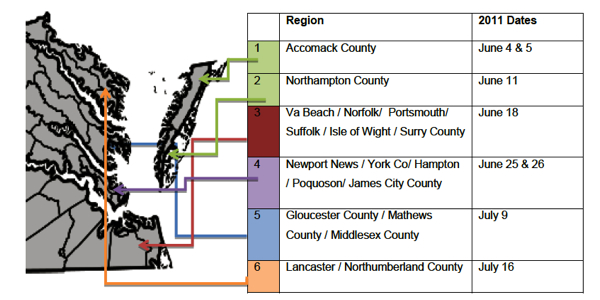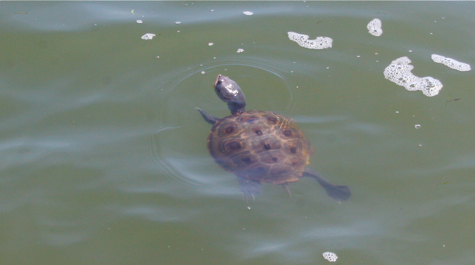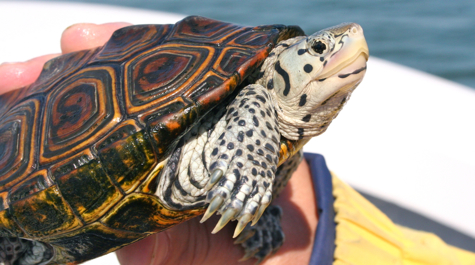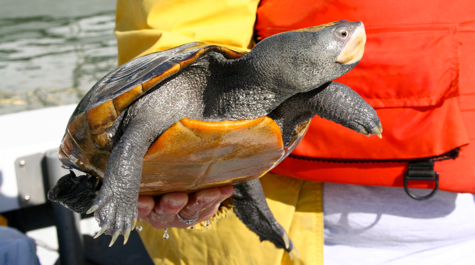VIMS grad student organizes first-ever statewide terrapin survey
Volunteers help to observe and count Bay turtles
Graduate student Diane Tulipani of the Virginia Institute of Marine Science has organized a statewide, volunteer-based survey of diamondback terrapins, a unique species of brackish-water turtle whose numbers are thought to be in decline due to habitat loss, nest predation, and drowning in crab pots.
Tulipani’s “TerpSearch” will be the first-ever comprehensive study of diamondback terrapin populations in Virginia, and could lead to more effective management of activities that contribute to terrapin mortality in the Commonwealth. Tulipani hopes that the project will also serve as a model for similar citizen-led surveys in other states that these turtles call home. Terrapins inhabit coastal bays, estuaries, and salt marshes from Massachusetts to Texas.
Tulipani, a Ph.D. student in the College of William and Mary’s School of Marine Science at VIMS, has been studying the ecology and feeding habits of Malaclemys terrapin since 2008. Her research has already revealed the previously unknown fact that these aquatic reptiles eat eelgrass seeds, and thus may play a role in the spread of this important Bay vegetation.
The main goal of the survey, says Tulipani, is “to record whether or not terrapins occur in selected areas of Virginia’s portion of Chesapeake Bay, and to estimate their population through careful counts of surfacing turtles.”
The survey will take place on weekends from June through mid-July within six areas along Virginia’s Chesapeake Bay shoreline, from Hampton Roads and the Northern Neck to Accomack and Northampton counties on the Eastern Shore. Each area may contain up to 90 observation sites. A second survey season is planned for summer 2012.
Tulipani says the survey results will help clarify the conservation status of diamondback terrapins in Virginia, which is currently muddled due to a lack of recent data concerning the turtle’s abundance and distribution.
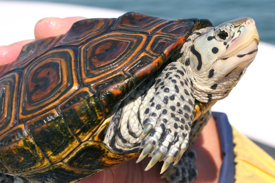
“Diamondback terrapins are considered a ‘species of concern’ in Virginia,” says Tulipani, “Their current population status is basically unknown, yet there’s good reason to believe that they’re in decline due to loss of marsh habitat and drowning in crab pots.” Data from a study by W&M biology professor Randy Chambers and graduate student Megan Rook confirm these threats and add another—nest predation by raccoons. Like sea turtles, terrapins lay their eggs in nests dug into sandy beaches.
The collected information will be summarized in a report to federal and state conservation and wildlife agencies, as well as the general public.
Survey and volunteers
Up to fifteen pairs of trained volunteers per day will conduct the “TerpSearch” survey from shore, in public areas near likely terrapin habitat. They’ll record any terrapins sighted during three 15-minute intervals at each survey site, snapping photos if possible and taking turns as observer and data recorder. The teams will also look for evidence of terrapins on land, such as the shells of dead turtles and nests that have been opened by predators.
“Terrapins aren’t easy to spot,” says Tulipani. “All you typically see is a head sticking out of the water for a few moments when they surface for air.” Tulipani is using video footage from her own fieldwork to help the volunteers develop a “search image” that will allow them to distinguish surfacing terrapins from crab-pot floats and other flotsam.
Tulipani says she’s already filled most of the volunteer positions, though a few spots remain open. The volunteers have mostly come from local conservation groups like the Virginia Herpetological Society and the Virginia Master Naturalists.
Kory Steele, president of the Virginia Herpetological Society and one of the TerpSearch volunteers, says his personal and professional involvement in the survey is motivated by a number of factors.
“We haven’t done nearly as much with terrapins as with our inland reptiles and amphibians,” says Steele. “Now we’ve got someone who is going to do a local survey that could have potentially huge impacts on the conservation of these animals, which have this reputation as being extraordinarily endearing. It’s multidimensional—there are so many reasons why we want to be involved.”
The TerpSearch volunteers will work mainly from public lands that Tulipani has identified as providing likely terrapin habitat. These include state wildlife management areas, the Chincoteague National Wildlife Refuge, public boat ramps, the Colonial National Historical Park and a few private residences. The National Park Service and the Virginia Department of Game and Inland Fisheries (DGIF) are assisting in the project. DGIF and a private donor have provided some of the funding.
Dates, Registration, and Information
Individuals or organization interested in volunteering for the survey can register on-line at http://bit.ly/terpsearch. To suggest potential observation locations, provide information about access, or gain further information, contact Diane Tulipani at dctulip@vims.edu or 804-684-7807.
Surveys will take place on the following dates (check registration page for any remaining volunteer openings):
- June 4-5: Accomack County (Eastern Shore)
- June 11: Northampton County (Eastern Shore)
- June 18: Virginia Beach, Portsmouth, Suffolk, Surry, Isle of Wight (south shore James River)
- June 25-26: Hampton, Newport News, & Poquoson
- July 9: Gloucester, Mathews, & Middlesex
- July 16: Lancaster & Northumberland
